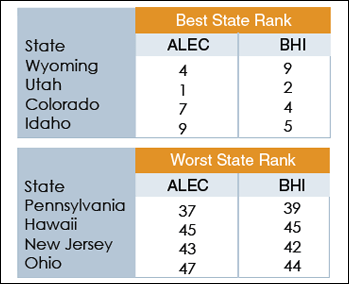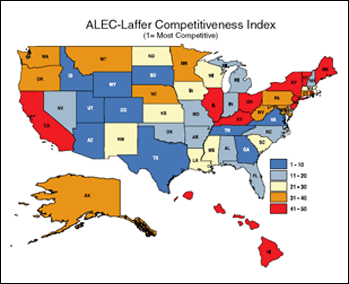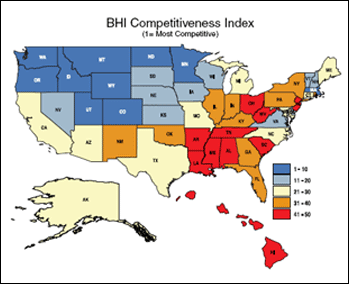| Two people can look at the same thing and see totally different images. Take the drawing below…do you see flowers and a butterfly, or a young woman? You can see both of them once you know what you are looking for. |
| |
 |
| |
| This “I-see-a-woman…no…I-see-a-flower” phenomenon also extends to the business world. Even a casual observer of economic development activities is exposed to countless rankings of business climate, best places to live, and many more, all of which attempt to identify the same thing, that is, the best place to invest…either your money or your employer’s. Herein we present two such analyses that ostensibly measure the same thing, but with significantly different results. |
| |
| ALEC-Laffer State Economic Competitiveness Index- This is a forecast of economic development prospects based on current measures of 16 state-level metrics such as top marginal personal and corporate income tax rates, property and sales tax burdens, workers compensation insurance costs, and others. |
| |
| BHI State Competitiveness Rankings Index- This is an aggregation of key microeconomic variables that predicts a state’s ability to ensure and sustain a high level of per capita income and growth. It includes measures of state fiscal policies, human resources, business incubation, environmental policy, and more. |
| |
| In a few instances, these two rankings produce similar results. For example, both cite Wyoming, Utah, Colorado and Idaho among the best states, and are in agreement that Pennsylvania, Hawaii, New Jersey and Ohio are among the worst. |
| |
 |
| |
|
|
|
|
| But there are also major differences. Alabama and Georgia are among the best states in the ALEC study, but near the bottom of the BHI analysis. ALEC ranks Vermont the worst state in the country, while BHI ranks it 13. Washington, Minnesota and Oregon are ranked 6, 7 and 8 by BHI, but 31, 35 and 36 by ALEC. |
| |
| Drawing on Walker’s years of experience in site selection of industrial facilities, it’s our belief that both assessments miss the mark. Neither takes a hard look at the three issues that drive most site selection decisions: labor cost, labor availability and labor unions. |
| |
| Corporations don’t (or shouldn’t) pick states for new facilities, they pick locations, and reliance on state-level measures is akin to studying astronomy without a telescope. Just because a state may not rank well on a measure doesn’t mean there aren’t excellent options within the state. And the three labor issues mentioned above are only meaningful if measured at the local, not state level. |
| |
That said, of the two studies the ALEC analysis is the best representation of reality. The Sun Belt has captured the lion’s share of new investment over the years, and many of these states rank high in the ALEC study. California and many northeastern states have operating climates most companies wish to avoid, and they are low-ranking options in the ALEC study. |
| |
 |
| [Place cursor over map to enlarge] |
| |
 |
| [Place cursor over map to enlarge] |
|